This post may contain affiliate links. Please read our disclosure policy.
This homemade 1 pot vegetable stock utilises fresh vegetables and/or vegetable scraps to make a delicious homemade vegetable broth that is vegan, gluten-free, salt-free, dairy-free etc.
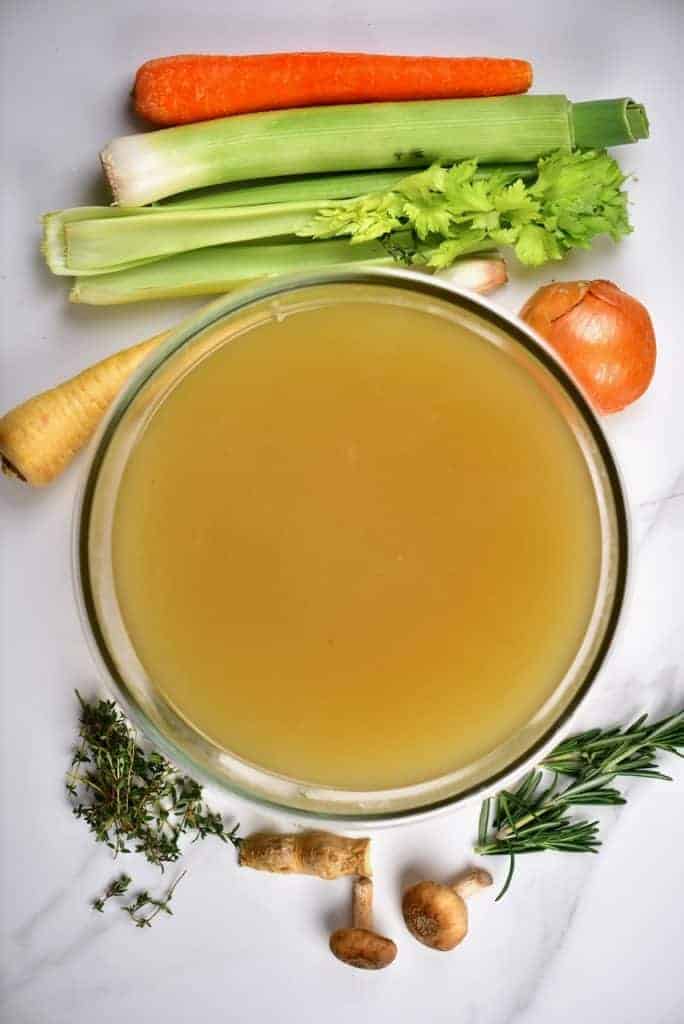
Unfortunately, as a food blogger, I have a LOT of vegetable scraps and nowhere to put them. I live in an area where there isn’t a good food waste system (unfortunately London is a bit behind in this!). However, this homemade vegetable stock takes less than an hour to make, is cheaper than store-bought vegetable broth /stock tablets and without any nasty additives, thickeners or a high sodium level.
Now, I keep a bag in the freezer for all of the vegetable scraps that I don’t use in a recipe. This usually includes the tops and peel or various vegetables like carrots and onions, as well as additional veg that wasn’t used during the week.
Once the bag is full, then it’s time to make some stock (you can also use the scraps as and when needed). For this post, I’ve included an actual ‘recipe’ with amounts of fresh produce. This is just a guideline, as the majority of the time, your scraps aren’t measured and will differ from month to month.
Unfortunately, stock tablets/stockpot and store-bought broth are usually high sodium with hidden thickeners/additives. Luckily, making homemade vegetable stock is ridiculously simple, and you are 100% in control of all of the ingredients added and the amount of salt.
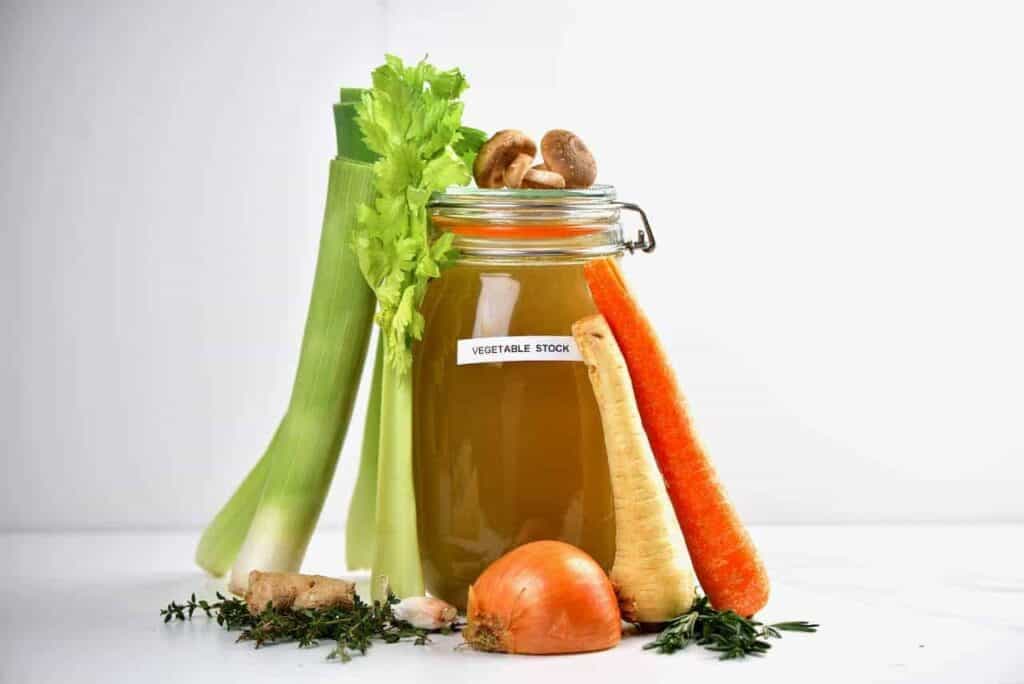
Want to save this recipe?
Tips For Delicious Homemade Vegetable Stock Every Time
Use Organic Vegetables: I know this isn’t always affordable or possible for everyone. However, I always suggest using organic vegetables when making homemade vegetable stock to avoid nasty pesticides. Even when using organic, I tend to scrub my veggies anyway. I then use the peels/skins within the broth for extra flavour and nutrients.
Roasting your vegetables first: For a heartier version of vegetable broth then you can roast your veggie scraps first in the oven with olive oil. I don’t do this a lot as it adds a step to the process. However, the caramelisation of the vegetables adds wonderful extra flavour to the stock.
Adding Mushrooms for Umami: A few dried mushrooms work wonders at adding a noticeable new ‘layer’ of flavour to your stocks. While it isn’t as strong as using fresh mushrooms, I don’t have a lot of mushroom ‘leftovers’ usually, so I keep a bag of dried mushrooms in my pantry.
Be Aware Of Your Heating Time: Some people believe that the longer you heat your stock, the richer the flavour. Meanwhile, others say that you should never boil the stock for longer than an hour. It’s believed that by this time your veggies will have imparted all the flavour and nutrients that they can- Any longer will further break down the vegetables and absorb some stock, that you’ll then lose from your final yield.
It can also affect the flavours as herbs and certain vegetables may produce a bitter broth if cooked for too long.
However, there is also a ‘steeping’ method said to yield amazing results; where you begin your stock boil for 10-15 minutes, remove from the heat and leave in the fridge overnight and then finish off boiling the following day. This long steep is said to enhance all the flavours without adding a lot more ‘cooking’ time.
Experiment: Homemade stock is fantastic because no two stock is identical. The tastes will change seasonally and according to what you’re using more/less of month to month. I suggest experimenting a lot.
When you store your stock label it/ take note of what the dominant ingredients were. That way, you can keep track of what your favourite versions are.
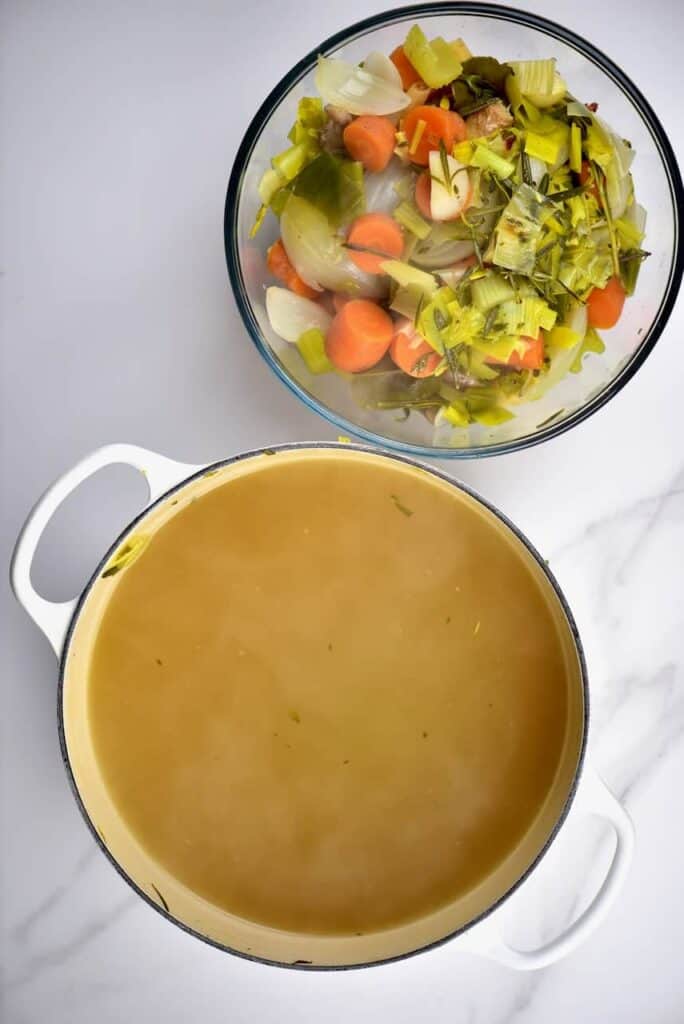
Note* If you find that your stock is slightly bitter and you can’t figure out why, it may be because you’re adding certain ingredients to your stock too early. Certain herbs and ingredients like peppercorns can become bitter if cooked too long.
Other Homemade Vegetable Stock FAQ’s
I’m no expert here in comparison to those that have been making stock for decades. So if you have more answers and tips to any of these FAQ’s, I’d love to know in the comments.
To Use or Not Use Starchy Vegetables? Using potatoes, parsnips and other starchy vegetables is fine for vegetable stock. However, it will affect the clarity of the stock as it makes it ‘murky’. It can also affect the texture if you use too much. If you want a clear stock for a stock-based soup, then avoid adding starchy vegetables.
Can you make stock in an Instant Pot/ Pressure Cooker? Yes- I haven’t personally tried this as I don’t own either, however, a relative of mine has made stock in her instant pot using the pressure feature for around 30-35 minutes with excellent results.
How do you store the homemade veggie stock? Leave the broth to cool to room temperature and then store in an airtight container in the fridge for 5-7 days or in the freezer for around three months.
What can you do with the leftover vegetable scraps after making stock? This usually depends on exactly what you’ve used in your stock and how much they’ve broken up. If you’re making a stock with new, bought veggies, then you can use the cooked veggies to puree into a soup.
The broken-down vegetable scraps can also be used for compost (a great idea to eliminate food waste). They can even be dehydrated and ground into a vegetable flavour powder/ seasoning.
What vegetable scraps should I avoid using? I mostly use the same vegetable scraps when making my stock, so I don’t know much about this. I tend to avoid beets as they can overpower the broth and affect the colour too. Celery is a strong flavour in general, but the outer leaves can get bitter when slowly boiled, the same goes for courgette. The same goes for certain ‘stems’ like carrot tops and dandelion greens.
What other vegetables can I use? I’ve used all sorts of scraps from vegetables, to herbs etc. Stems of herbs work well as long as they’re not too bitter, as do peppers, tomatoes, broccoli and cauliflower greens etc. Fennel is also an ingredient that I’ll use a lot, as it adds a beautiful flavour.
In general, I’ll always have onion, carrots and mushrooms in my broth and often celery/ leek as these are a great ‘base’. I love using bay leaves too, the majority of the time.
What else can I add into the stock? With this recipe, I’ve kept my stock salt-free. However, there are a few ingredients you can add that will affect the flavour- For example, soy sauce and miso paste for savoury. Nutritional yeast adds a nutty, cheesy flavour which is lovely within a vegan broth. Note- parmesan rinds are often used in broths, but these contain rennet.
Alternatively, you can also experiment with additions like balsamic vinegar, Worcestershire sauce or even wine. I tend to avoid these additions (and salt) unless I have a specific recipe in mind for the stock that matches those flavours. That way, I can season each dish according to its needs.
How to Make Homemade Vegetable Broth
The process is ridiculously simple. Collect your scraps, throwing them into a pot with some water and boil them. Strain the resulting liquid and voila, stock.
Okay, I suppose there’s a little more to it than that- but that is the basic idea. For this stock recipe, I’m using fresh vegetables, not scraps so that the process will differ slightly in term of prep.
Note* These are just guidelines for a specific ‘starter’ stock to get you started and experimenting with flavours. Usually, I would use vegetable scraps from my freezer bag and suggest you do the same to make the most of your veggies and herbs, reduce food waste and save money.
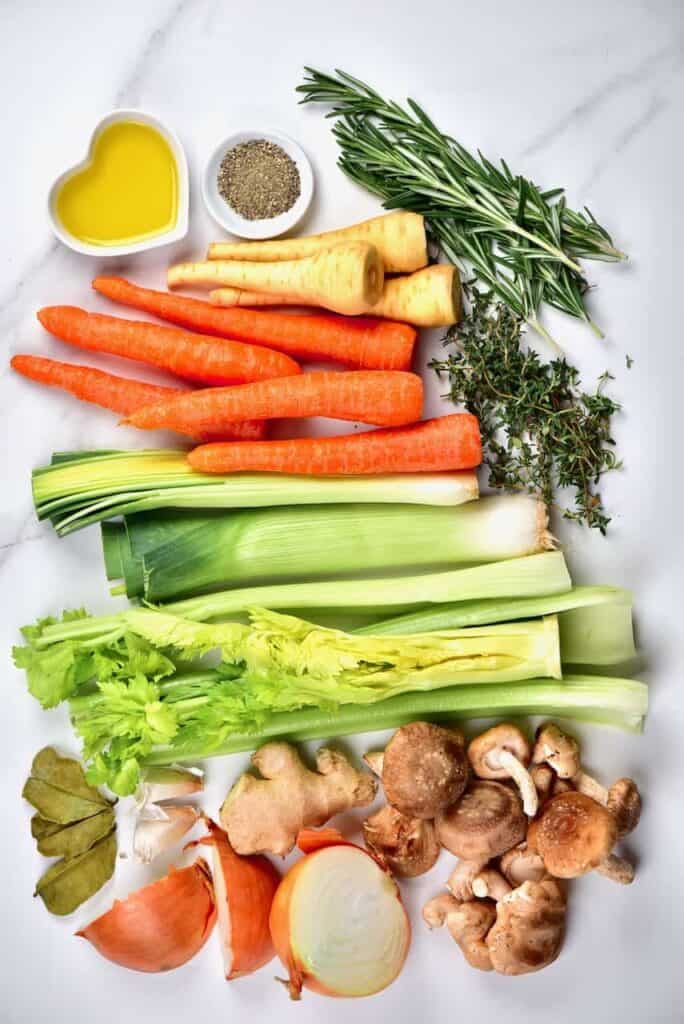
Note: *salt – I omitted salt entirely in this vegetable broth /stock as I use the stock to flavour other soups and dishes where I’ll add salt. By omitting the salt here, the other dishes don’t become too salty. The same goes for strong spices and flavourings like garlic, wine etc. I’ll usually only add these if I have recipes in mind where these flavours will work.
The How-To
Begin by gathering all your vegetables – if you have a bag of scraps, then use them. Alternatively, use the ingredient suggestions in my recipe and begin by chopping the vegetables roughly. Feel free to leave the skin on the onion – I chose to remove it as I knew I would be blending the leftover vegetables into a soup. However, if you’re using vegetable scraps then go ahead and use the skins too (I always include carrot peels).
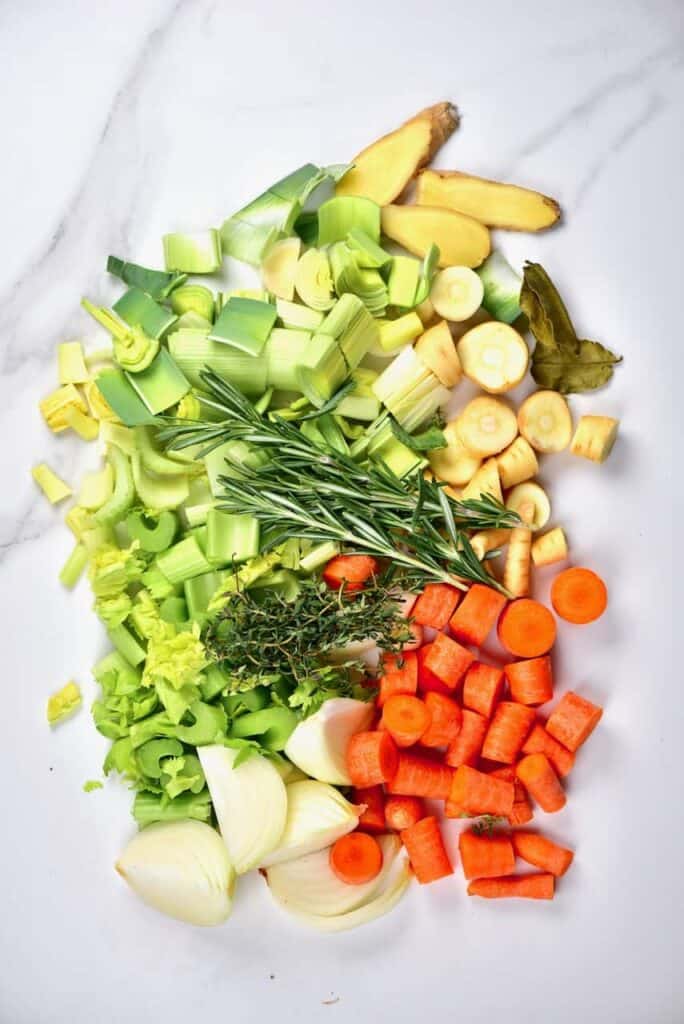
In a big saucepan, heat the oil, then add the onion, garlic and ginger and stir-fry for about a minute, to lightly caramelise. (Or up to 5 minutes, for more caramelisation which will add depth of flavour to your stock).
However, note, when using vegetable scraps from frozen, these won’t caramelise because of the water content from the ice. You could leave them to defrost and then do this step or use vegetable scraps that haven’t been frozen. A pressure cooker could also work to caramelise the veggies ends, from frozen (although I haven’t tried it).
Add the rest of the ingredients, apart from the pepper, and pour over 12 cups of filtered cold water.
Bring to boil on high heat, stirring occasionally. Then cover, reduce the heat and simmer for 45-60 minutes. Add the pepper in the last 5-10 minutes.
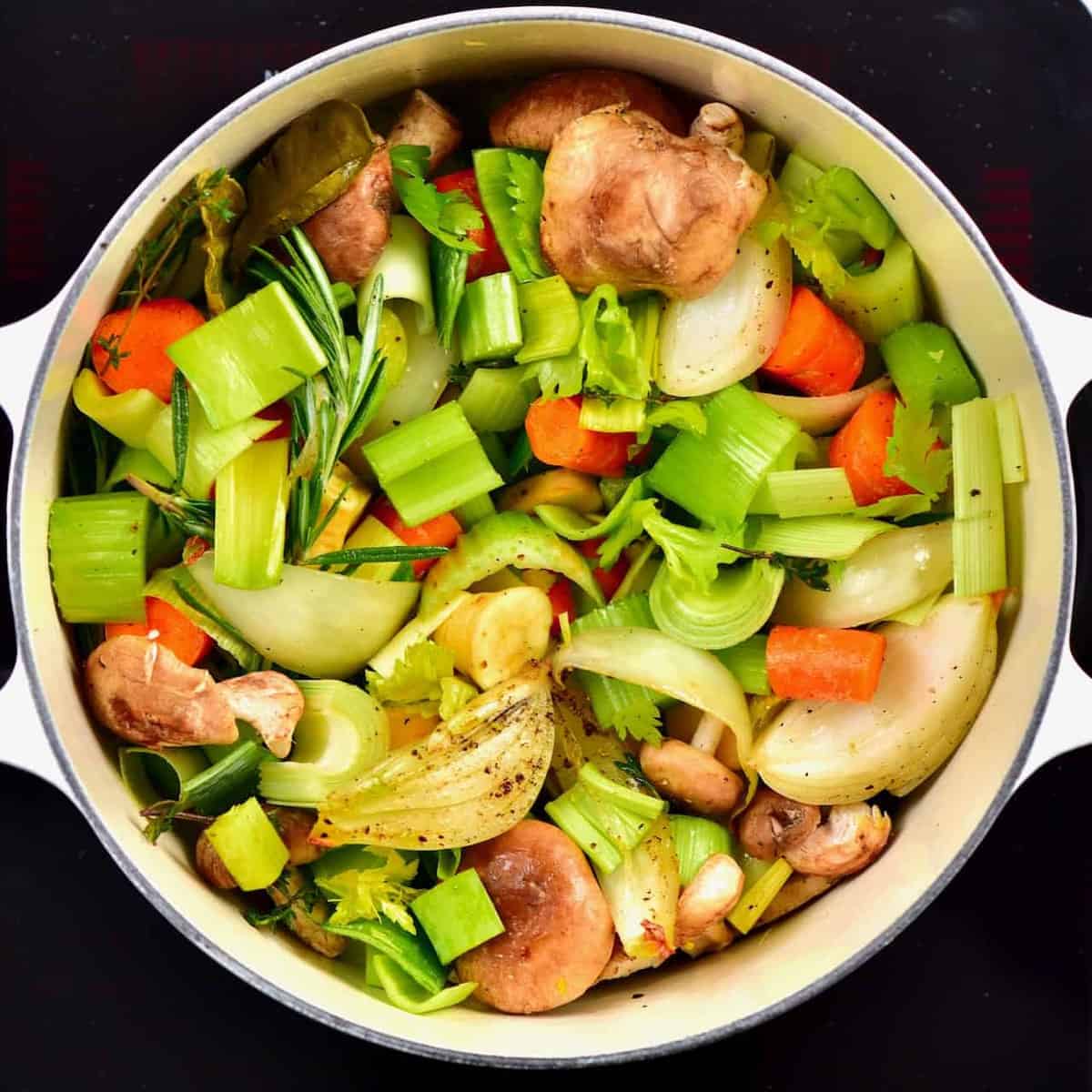
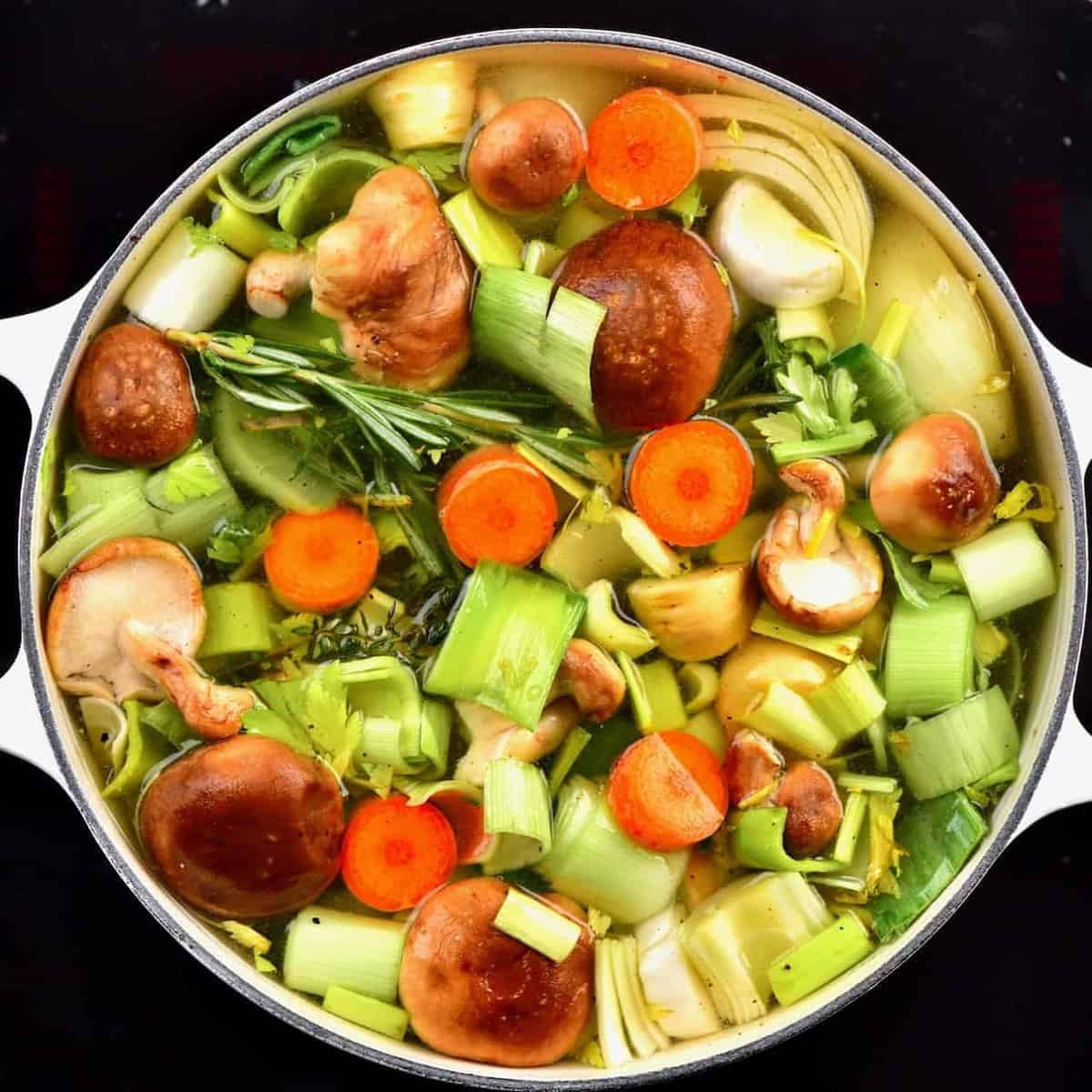
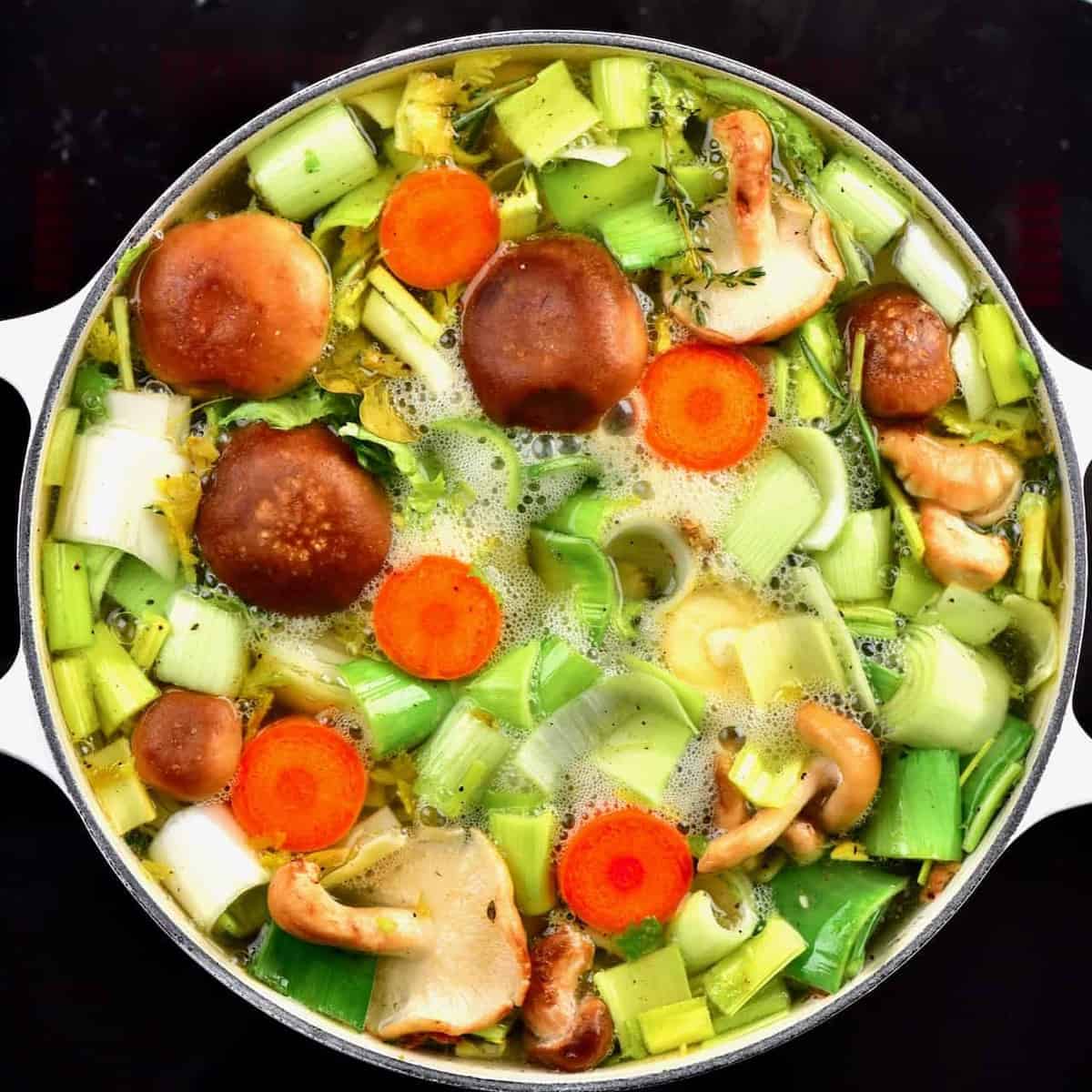
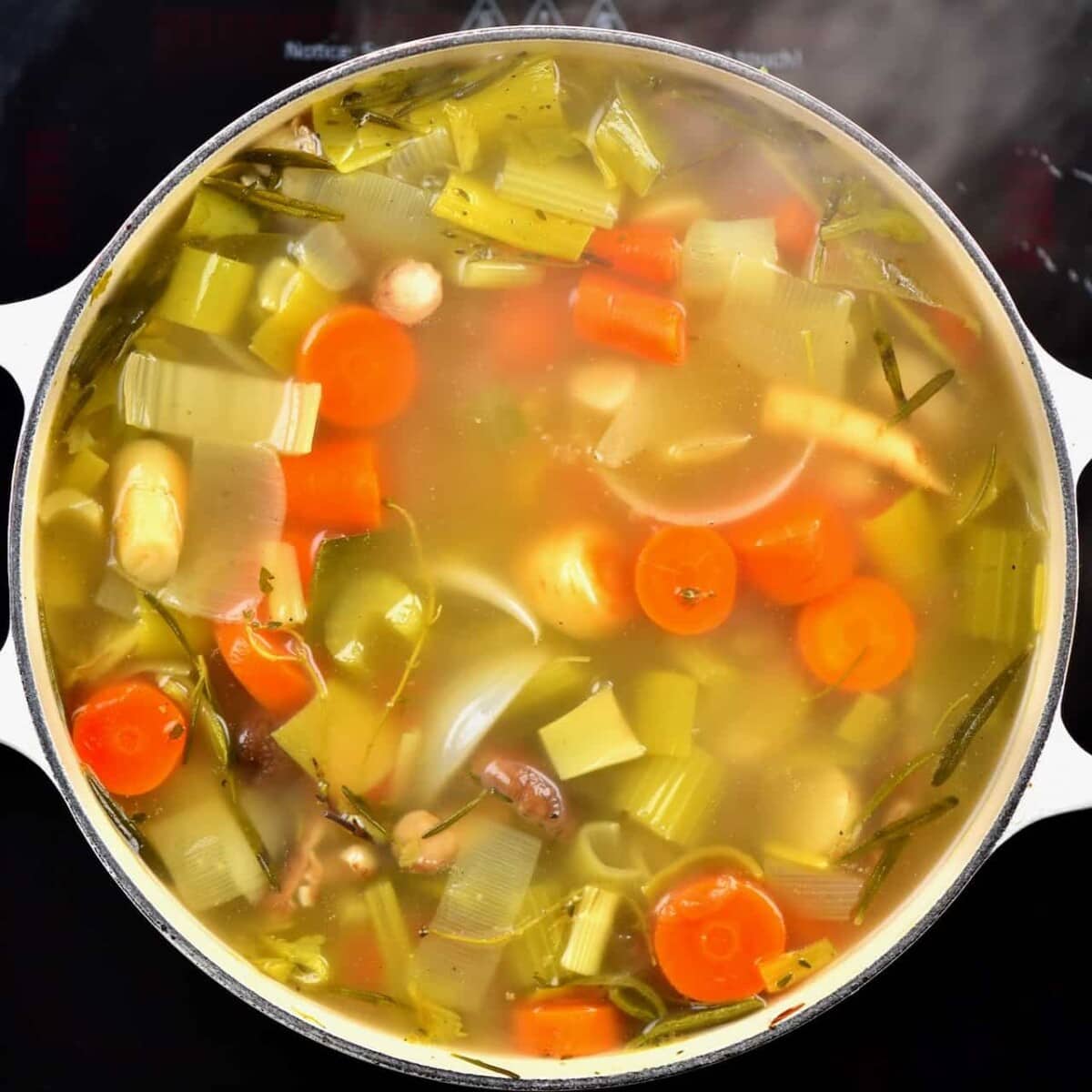
Remove the veggies from the vegetable broth with a slotted spoon.

Pour the remaining liquid through a fine-mesh sieve into another large bowl.
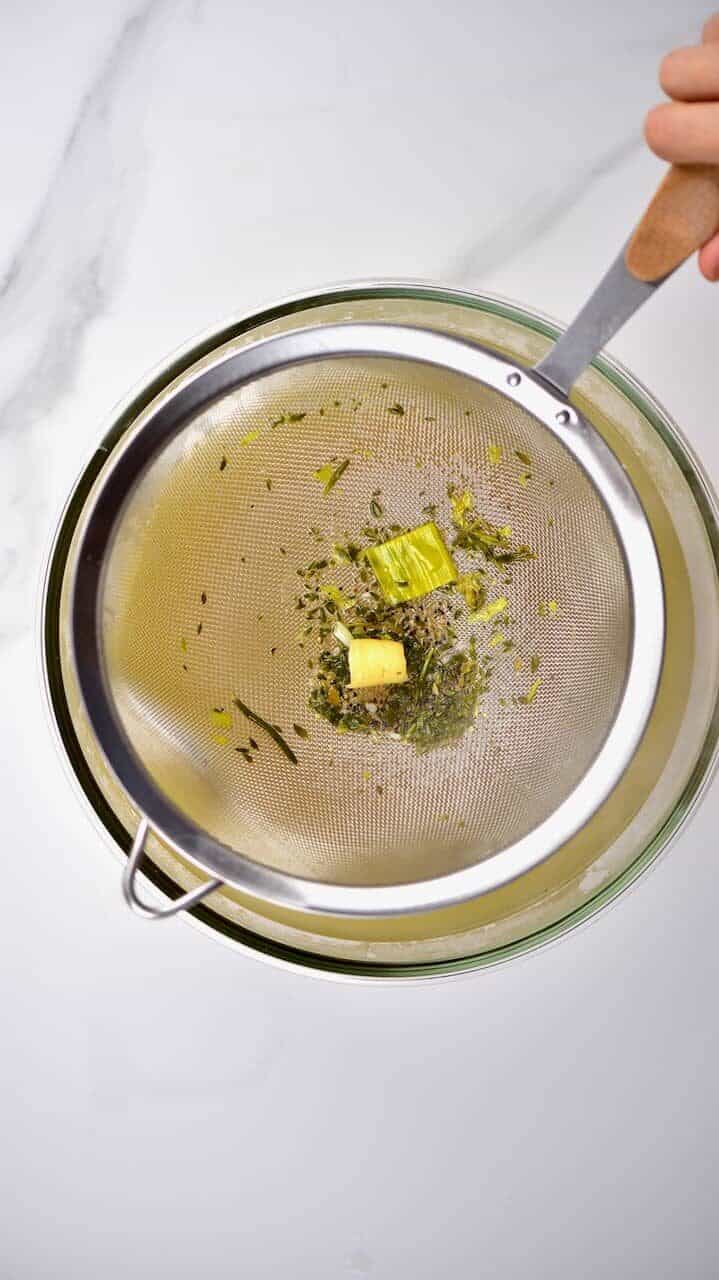
The leftover veggies can be mashed or blended into a creamy soup.
Let the vegetable broth cool down completely before storing. Store in the fridge for up to a week or in the freezer for up to 3 months.

This stock can then be used within soups, risotto and a variety of other uses including this delicious Japanese-Inspired Ramen Bowl.

If you have any questions, feel free to ask them in the comments. And, as always, I love to see your creations, so feel free to tag me @AlphaFoodie.
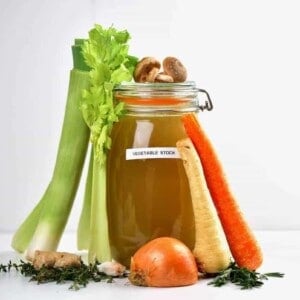
How to make Vegetable Stock
Equipment
- Pot
Ingredients
- 12 cups filtered water
- 5 small carrots
- 3 small parsnips
- 1 leek
- 3-4 stalks celery
- 1 cup shiitake mushrooms
- 1 onion
- 2-3 garlic cloves
- 3 slices ginger
- 1 tBSp olive oil
- 3 bay leaves
- a handful of thyme
- handful of fresh rosemary
- 1/2 tsp black pepper
- 1 tsp salt optional*
Instructions
- Begin by gathering all your vegetables – if you have a bag of scraps then use them. Alternatively, use the ingredient suggestions in my recipe and begin by chopping the vegetables roughly.*

- In a big saucepan, heat up the oil, then add the onion, garlic and ginger and stir-fry them for about a minute, to lightly caramelise ( up to 5 minutes, for more caramelisation which will add depth of flavour to your stock).**

- Add the rest of the ingredients, apart from the pepper, and pour over 12 cups of filtered cold water.

- Bring to boil on a high heat, stirring occasionally. Then cover, reduce the heat and simmer for 45-60 minutes. Add the pepper in the last 5-10 minutes.

- Remove the veggies from the vegetable broth with a slotted spoon then pour the remaining liquid through a fine-mesh sieve into another large bowl. The leftover veggies can be mashed or blended into a creamy soup.

- Let the vegetable broth cool down completely before storing. Store in the fridge for up to a week or in a freezer-safe container in the freezer for up to 3 months.

Video
Notes
- For more notes and suggestions look at my TIPS and FAQ’s sections on the blog post.
- Note* These are just guidelines for a specific ‘starter’ stock to get you started and experimenting with flavours. Usually, I would use vegetable scraps from my freezer bag and suggest you do the same to make the most of your veggies and herbs, reduce food waste and save money.
- I omitted salt entirely in this vegetable broth /stock as I use the stock to flavour other soups and dishes where i’ll add salt. By omitting the salt here, the other dishes don’t become too salty. The same goes for strong spices and flavourings like garlic, wine etc. I’ll usually only add these if I have recipes in mind where these flavours will work.
- * Feel free to leave the skin on the onion – I chose to remove it as I knew I would be blending the leftover vegetables into a soup. However, if you’re using vegetable scraps then go ahead and use the skins too.
- ** When using vegetable scraps from frozen, these won’t really caramelise because of the water content from the ice. You could leave them to defrost and then do this step or alternatively, use vegetable scraps that are fresh and haven’t been frozen. A pressure cooker could also work to caramelize the veggies ends, from frozen ( although I haven’t tried it).
Nutrition
Nutrition information is automatically calculated, so should only be used as an approximation.

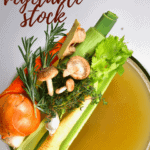
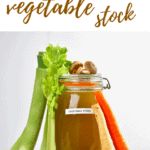
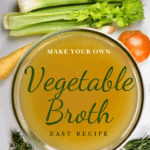
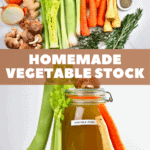
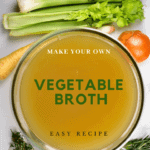
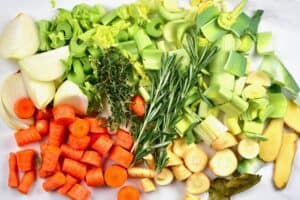
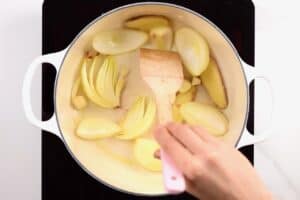
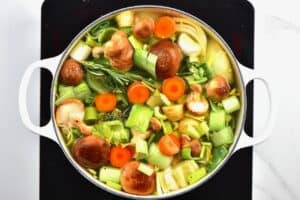
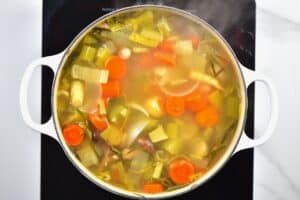
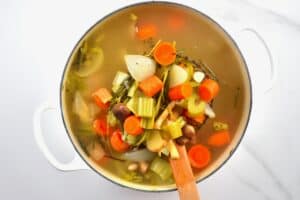
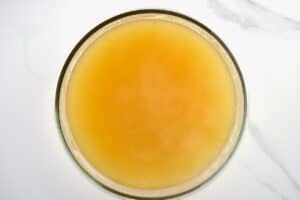









I’ve tried this twice and it always comes out too bitter to be used so now I’ve given up. I wanted to do it to reduce food waste before composting but now… after two failed trials and not sure why, I’ve given up. Most of the food scraps I used is really nothing special: onion peel, garlic butts and peel, herbs branches, celery “ugly” bits and leaves (not too much tho), any other veggie butts or non edible parts
Thank you for your feedback, Minnie. Sorry it’s not working for you, it really all depends on what type of scraps you use. Composting is great though 🙂
I’m gonna try this way, since other times I’ve done veggie stock the flavour ended to be a little bitter. It might have been because I added the pepper too soon or left it simmering too long.
I like the idea of herbs and ginger, I hope the flavours combine well!
I’ll keep you updated. 😉
Thank you for your comment, Mer. I hope you like the recipe 🙂
I’m very grateful for the time you spend to share your knowledge. I really appreciate. Thanks
Thank you so much, Paola.